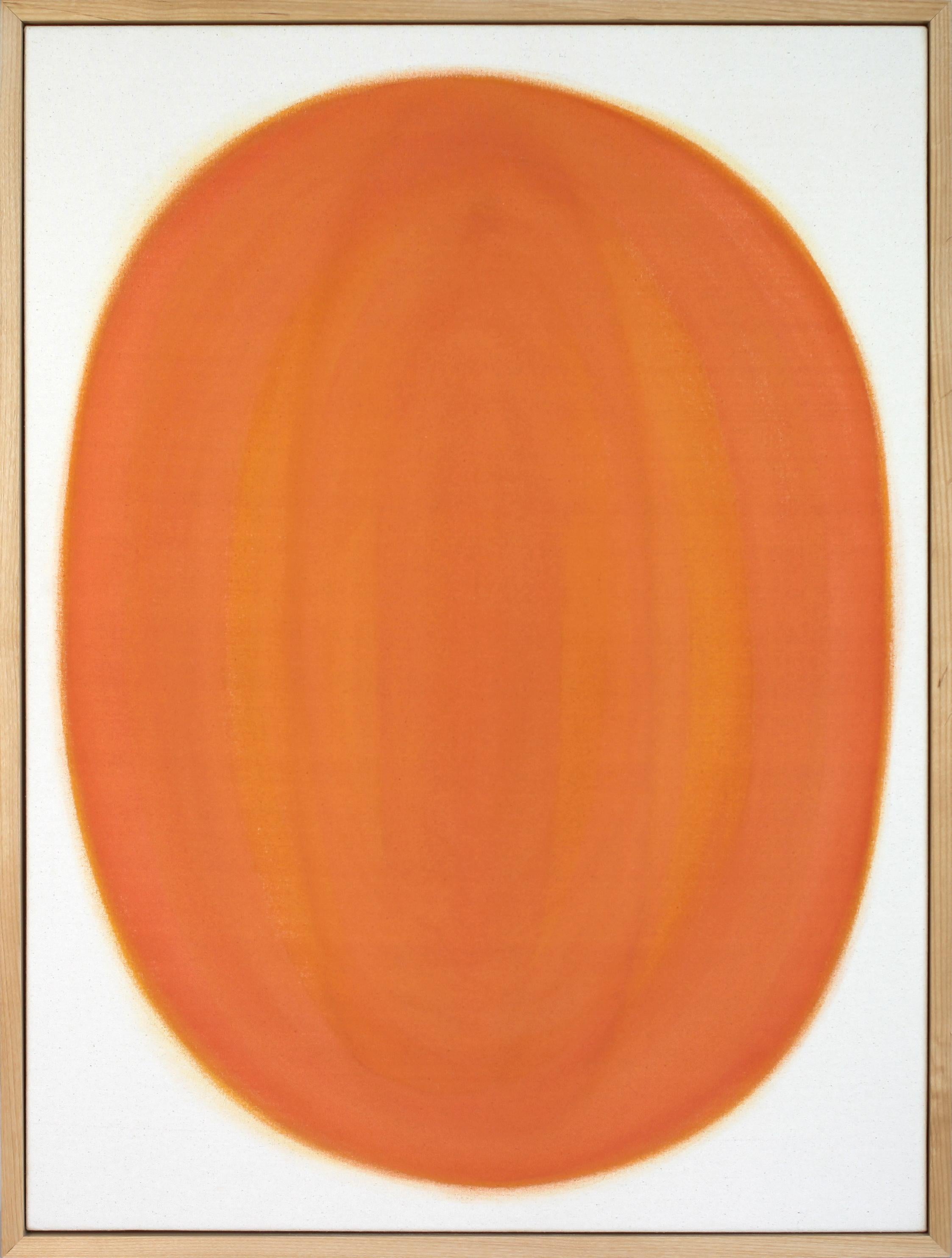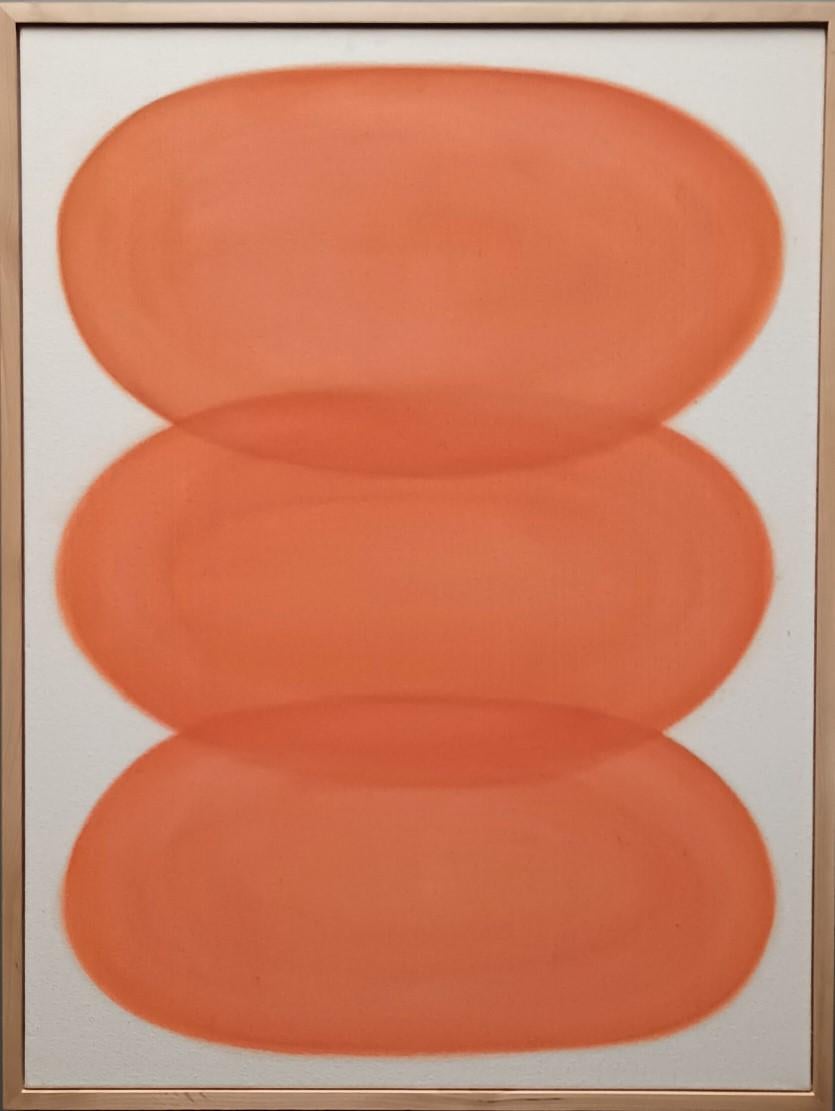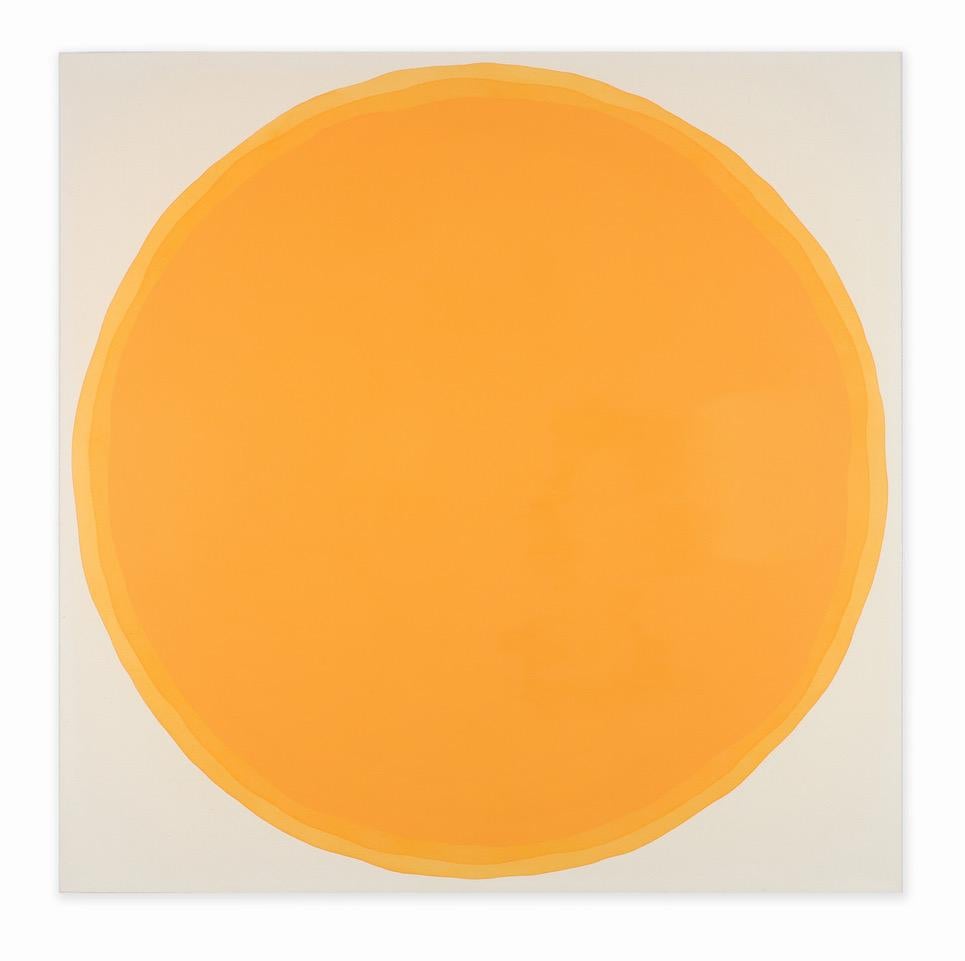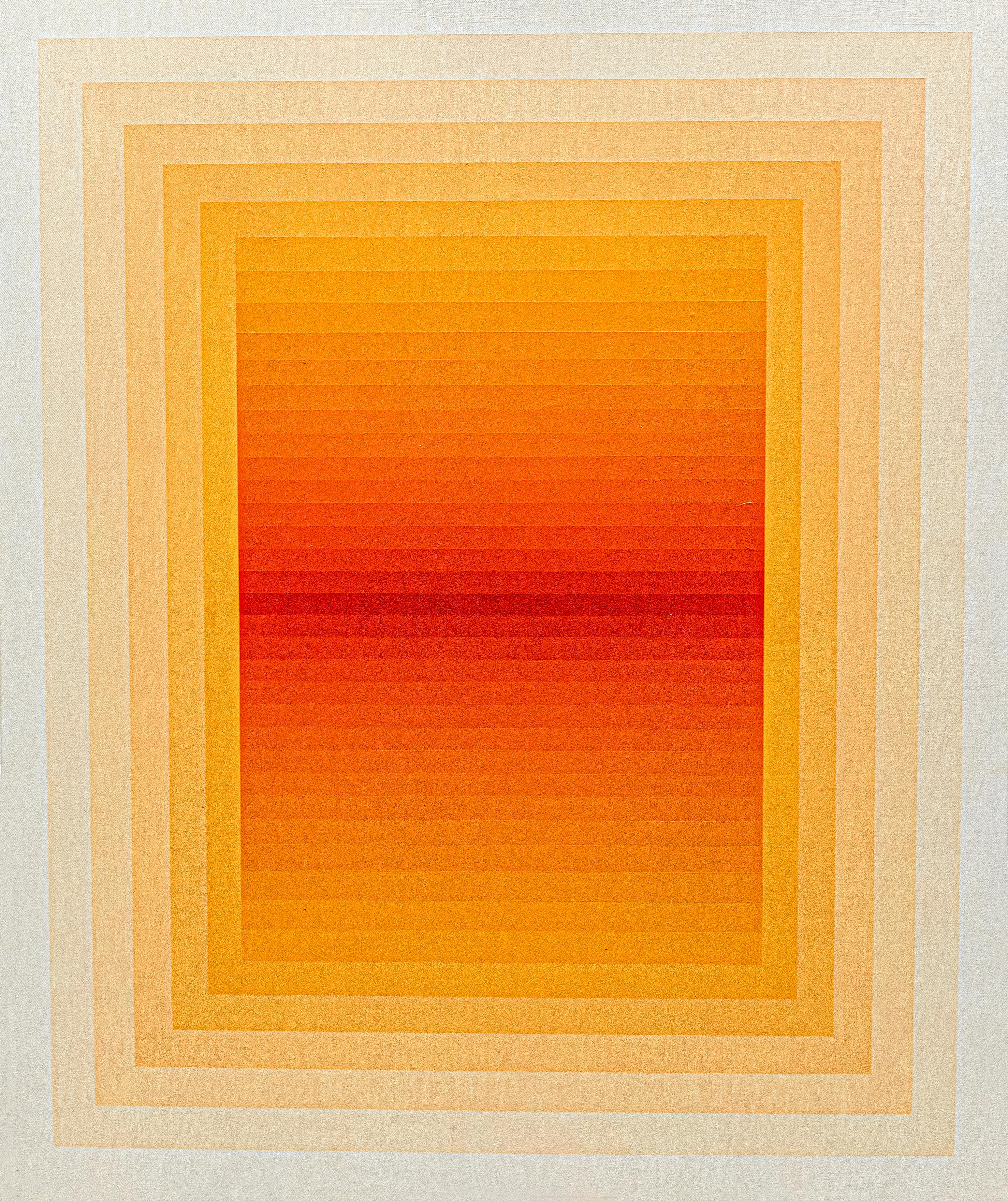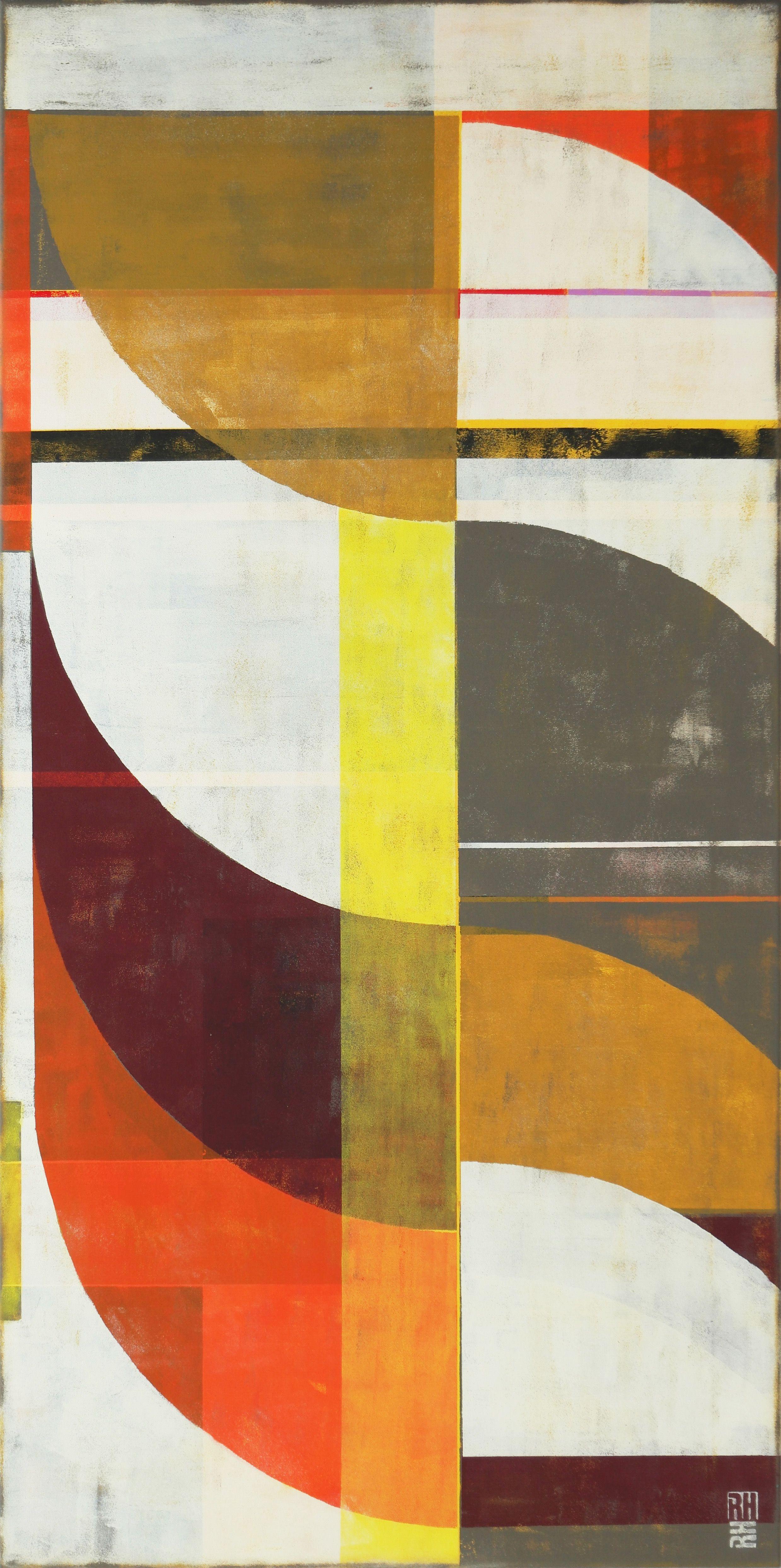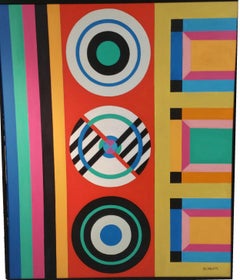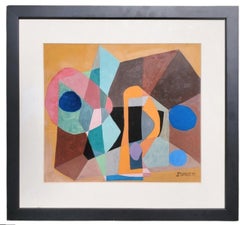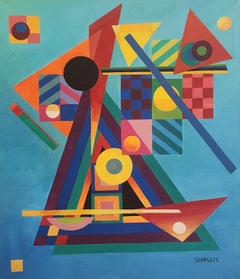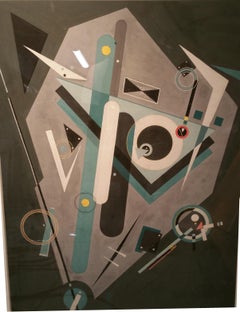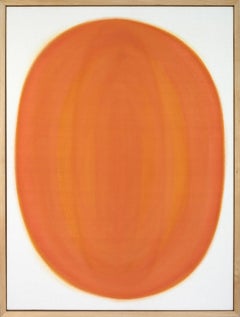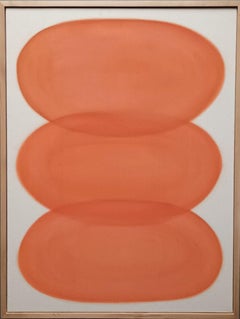Want more images or videos?
Request additional images or videos from the seller
1 of 6
Paul ReedOrange Circle1965
1965
$15,000
£11,365.34
€13,040.83
CA$21,107.42
A$23,202.86
CHF 12,194.36
MX$281,767.26
NOK 152,121.58
SEK 144,124.50
DKK 97,327.03
About the Item
Signed & dated Verso. 1965
Paul Reed in 1970. He favored “staining” untreated canvas.
Paul Reed, the last surviving member of the Washington Color School, who explored the complexities of color and form in vibrant bio-morphic and hard-edge abstract paintings, died on Sept. 26 at his home in Phoenix. He was 96.
His death was confirmed by his daughter, Jean Reed Roberts.
Mr. Reed acquired his public identity as an artist when he was included, along with Gene Davis, Kenneth Noland, Morris Louis, Thomas Downing and Howard Mehring, in “The Washington Color Painters,” a landmark traveling exhibition that began at the Washington Gallery of Modern Art in 1965.
All of the other painters had been shown, the year before, in “Post-Painterly Abstraction,” a 31-artist exhibition at the Los Angeles County Museum of Art organized by the critic Clement Greenberg in an effort to write a new chapter in the historic march of abstract art.
Like his fellow Washington artists, Mr. Reed rejected the hot, gestural approach of Abstract Expressionism and explored color and abstract forms in a cooler mode. Working with diluted acrylic paint, in discrete series that methodically explored formal issues, he created luminous fields of color by letting the paint bleed into, or stain, untreated canvas.
“I have a saying: Pollock dripped, Frankenthaler poured,” he told The Washington Post in 2011, referring to the artist Helen Frankenthaler. “Morris Louis poured. Howard Mehring sprinkled. I blot.”
In his first stained series, “Mandala,” color radiated from a circular central image. The nearly 100 paintings in his “Disk” series, which he called “a matrix for exploiting color,” consisted of a central circle and two triangles positioned at the corners of the canvas.
Over the next decade he moved to hard-edge geometric zigzags and stripes in the vertical “Upstart” series, color grids and shaped canvases that allowed for more complex experiments in form and color relations. He also made welded steel sculptures and, in the “Quad” series of the 1980s, collaged photographs.
“Reed was, in a sense, the ‘little master’ of that first batch of Washington colorists,” the critic Benjamin Forgey wrote in The Washington Post in 1997. “He was a latecomer — he didn’t turn seriously to painting until he was in his mid-30s — but he never considered becoming anything other than an abstract painter. And when he was ready to show, in his early 40s, he was a very good abstract painter indeed.”
Mr. Reed gave himself a more modest assessment in an interview with NPR last year. “I’m sort of low man on the totem pole of that group of six,” he said.
Paul Allen Reed was born in Washington on March 28, 1919. After graduating from McKinley Technical High School, he studied art for a semester at San Diego State University but, short of money, he returned to Washington to work as a graphic artist at The Times-Herald, taking art classes at the Corcoran School of Art at the same time. He was rejected for military service because of poor hearing.
Mr. Reed worked for a short period as a graphic designer with an advertising agency in New York just as Abstract Expressionism was taking off, but he returned to Washington in the early 1950s and started his own design agency. In 1962 he was hired by the newly established Peace Corps to oversee the design of its publications.
Mr. Reed had his first solo show in 1963 at the Adams-Morgan Gallery in Washington. The same year, in another solo exhibition, he showed his “Satellite Paintings” at the East Hampton Gallery in Manhattan. These were shaped canvases, each with a smaller companion canvas whose single image appeared to have been thrown off by the rotating, flower-like image of the main canvas.
Stuart Preston, reviewing the show for The New York Times, described the works as “an interesting and not unoriginal attempt to develop color dynamics with the curve instead of the safer straight line.”
In 1966 Mr. Reed was included in the exhibition “The Hard-Edged Trend” at the Smithsonian American Art Museum, and in 1971 he was appointed assistant professor at the Corcoran School of Art, where he taught for the next decade.
After his studio building was razed in 1972, Mr. Reed, who leaves no immediate survivors other than his daughter, began working in the basement of his home in Arlington, Va., where he turned to smaller formats, producing oil-pastel drawings, photo collages and gouache paintings on paper.
He began painting on canvas again in the late 1990s, introducing flat, rectangular bars of color that seemed to float over the picture plane.
In 2011 his work was included in “Washington Color and Light” at the Corcoran. His career was surveyed in the exhibitions “Evolution Through Color: The Art of Paul Reed,” at the Charles Marvin Fairchild Memorial Gallery at Georgetown University in 2010, and “Ultraviolet to Infrared: Paul Reed, 50 Years,” at the Workhouse Arts Center in Lorton, Va., in 2011.
In recent years, his work was shown in New York at D. Wigmore Fine Art, which has three early Reed paintings in its current exhibition, “1960s Hard-Edge Painting: L.A., D.C., N.Y.”
Credit: askart
- Creator:Paul Reed (1919, American)
- Creation Year:1965
- Dimensions:Height: 54 in (137.16 cm)Width: 40 in (101.6 cm)Depth: 3 in (7.62 cm)
- Medium:
- Movement & Style:
- Period:
- Condition:
- Gallery Location:Saratoga Springs, NY
- Reference Number:1stDibs: LU17021404093
About the Seller
4.2
Vetted Professional Seller
Every seller passes strict standards for authenticity and reliability
Established in 1992
1stDibs seller since 2015
31 sales on 1stDibs
Typical response time: 17 hours
- ShippingRetrieving quote...Shipping from: Saratoga Springs, NY
- Return Policy
Authenticity Guarantee
In the unlikely event there’s an issue with an item’s authenticity, contact us within 1 year for a full refund. DetailsMoney-Back Guarantee
If your item is not as described, is damaged in transit, or does not arrive, contact us within 7 days for a full refund. Details24-Hour Cancellation
You have a 24-hour grace period in which to reconsider your purchase, with no questions asked.Vetted Professional Sellers
Our world-class sellers must adhere to strict standards for service and quality, maintaining the integrity of our listings.Price-Match Guarantee
If you find that a seller listed the same item for a lower price elsewhere, we’ll match it.Trusted Global Delivery
Our best-in-class carrier network provides specialized shipping options worldwide, including custom delivery.More From This Seller
View AllGeometric Abstract
By Rolph Scarlett
Located in Saratoga Springs, NY
Signed lower left.
About the artist:
Rolph Scarlett was a painter of geometric abstraction during the American avant-garde movement of the 1930s and 1940s. Born in Guelph, Ontario,...
Category
1960s Abstract Geometric Abstract Paintings
Materials
Canvas, Oil
Geometric Shapes
By Rolph Scarlett
Located in Saratoga Springs, NY
Rolph Scarlett (1889-1984)
Geometric Shapes
Gauche on Paper
14 ½" x 13”
22" x 21" framed
In this original artwork, the artist transforms circles, shapes, and lines within an ide...
Category
1950s Abstract Abstract Paintings
Materials
Gouache, Archival Paper
Geometric Abstract
By Rolph Scarlett
Located in Saratoga Springs, NY
Signed lower right.
A major exponent of non-objective painting, Rolph Scarlett's career and artistic philosophy is closely linked with the early history of the Solomon R. Guggenhei...
Category
1960s Abstract Geometric Abstract Paintings
Materials
Oil, Canvas
Geometric Composition
By Rolph Scarlett
Located in Saratoga Springs, NY
Rolph Scarlett (Canadian/American, 1889 - 1984)
“Geometric Composition”
Signed lower right, circa late 1930’s early 1940’s
19 ½ x 26 inches
Mixed media, Price on request
About
Rolph Scarlett was a painter of geometric and linear forms, an industrial designer, and a pioneer in helping establish non-objective art as an aesthetic in America. He also worked in an abstract art style during the American avant-garde movement which extended into the 1940s. He was born in Guelph, Ontario, Canada and travelled to New York City as an 18-year-old. By 1924 he made New York City his home.
In 1939, Scarlett was one of the founding members and forces which steered the development of the Museum of Non-Objective Painting in New York. (later, the Solomon R. Guggenheim Museum). Guggenheim was the sponsor behind the Avant Garde and pioneering, philosophy of Baroness Hilla Rebay who founded the early museum. She was both the founding curator and director of the museum, as well as an abstract artist. She encouraged and worked with Scarlett in the early museum years, together promoting the concepts of non-objective painting. In Scarlett’s aesthetic these where geometric elements intuitively placed in non-descript flat and three-dimensional space.
Any discussion of the history of the Guggenheim Museum must include four key figures: Hilla Rebay (1890-1967), Wassily Kandinsky (1866-1944), Rudolf Bauer (1889-1953), and Rolf Scarlett...
Category
1930s Abstract Geometric Abstract Paintings
Materials
Mixed Media, Board
New Year
By Enrico Donati
Located in Saratoga Springs, NY
Signed & dated verso, 1992
Enrico Donati, a surrealist and abstract expressionist painter, was born in Milan, Italy in 1909 and died in Manhattan on April 25, 2008. He was known for his association with the surrealist movement of the 1940's, but his artwork continued to transform itself through the many trends that have occurred during his long career. In Italy he attended the Universita degli Studi in Pavia where he studied economics. In 1934, he moved to the United States settling in New York where he studied at the New School for Social Research and the Art Students' League.
Considered the surviving dean of the Surrealist Movement and a member of the New York School, Donati painted with Ernst, Matta and Tanguy in the thirties and forties, and in particular with Andre Breton, regarded by many to be the grand master of Surrealism.
He helped organize the Exposition Internationale du Surrealisme in Paris in 1947 where he exhibited three of his pieces. The Surrealists were known to avoid presenting or representing reality, and put the emphasis on invention and creativity by uncovering the poetic aspect of life with its kaleidoscopic multidimensional images, using reality only to enhance imagination.
Donati survived the decline of Surrealism in the late 1940's by adapting his style to current art trends as he worked with new materials and textures throughout the 1950's.
One trend with which he became involved was Abstract Expressionism, which originated in the 1940s, and became popular in the 1950s. It was a movement in which artists typically applied paint, rapidly and with force, to large canvases, in an effort to show feelings and emotions. Paint might be applied with large brushes, sometimes dripping or even throwing it onto canvas. Abstract Expressionist work is characterized by a strong dependence on what appears to be accident and chance, although it is actually highly planned.
Donati held a retrospective at the Palais des Beaux-Arts in Brussels in 1961 and went on to exhibit at the Betty Parsons Gallery with other forerunners of American Abstract Expressionism: Mark Rothko, Barnett Newman, and Jackson Pollock. It was at this time that Donati created some of his most inventive and extraordinary work, some of which was featured in a survey exhibition at the Alter & Gil Gallery, Beverly Hills, California, in January 2000.
He has held many teaching positions and has been an active lecturer, while continuing to add to his artistic repertoire. From 1960 to 1962 he was a Visiting Lecturer at Yale University, and from 1962 to 1972 a Member of the Yale University Council for the Arts and Architecture.
He has had seventy-five one-man shows, among them an exhibit of new paintings at the Maxwell Davidson Gallery (57th St., New York) in the fall of 1997. Donati's work is held in collections throughout the world, and his work has appeared in over 300 articles and publications, two hard cover books...
Category
1990s Abstract Abstract Paintings
Materials
Cotton Canvas, Mixed Media
$25,000
No Exit
By Enrico Donati
Located in Saratoga Springs, NY
Signed lower right and dated & titled verso.
Enrico Donati, a surrealist and abstract expressionist painter, was born in Milan, Italy in 1909 and died in Manhattan on April 25, 2008. He was known for his association with the surrealist movement of the 1940's, but his artwork continued to transform itself through the many trends that have occurred during his long career. In Italy he attended the Universita degli Studi in Pavia where he studied economics. In 1934, he moved to the United States settling in New York where he studied at the New School for Social Research and the Art Students' League.
Considered the surviving dean of the Surrealist Movement and a member of the New York School, Donati painted with Ernst, Matta and Tanguy in the thirties and forties, and in particular with Andre Breton, regarded by many to be the grand master of Surrealism.
He helped organize the Exposition Internationale du Surrealisme in Paris in 1947 where he exhibited three of his pieces. The Surrealists were known to avoid presenting or representing reality, and put the emphasis on invention and creativity by uncovering the poetic aspect of life with its kaleidoscopic multidimensional images, using reality only to enhance imagination.
Donati survived the decline of Surrealism in the late 1940's by adapting his style to current art trends as he worked with new materials and textures throughout the 1950's.
One trend with which he became involved was Abstract Expressionism, which originated in the 1940s, and became popular in the 1950s. It was a movement in which artists typically applied paint, rapidly and with force, to large canvases, in an effort to show feelings and emotions. Paint might be applied with large brushes, sometimes dripping or even throwing it onto canvas. Abstract Expressionist work is characterized by a strong dependence on what appears to be accident and chance, although it is actually highly planned.
Donati held a retrospective at the Palais des Beaux-Arts in Brussels in 1961 and went on to exhibit at the Betty Parsons Gallery with other forerunners of American Abstract Expressionism: Mark Rothko, Barnett Newman, and Jackson Pollock. It was at this time that Donati created some of his most inventive and extraordinary work, some of which was featured in a survey exhibition at the Alter & Gil Gallery, Beverly Hills, California, in January 2000.
He has held many teaching positions and has been an active lecturer, while continuing to add to his artistic repertoire. From 1960 to 1962 he was a Visiting Lecturer at Yale University, and from 1962 to 1972 a Member of the Yale University Council for the Arts and Architecture.
He has had seventy-five one-man shows, among them an exhibit of new paintings at the Maxwell Davidson Gallery (57th St., New York) in the fall of 1997. Donati's work is held in collections throughout the world, and his work has appeared in over 300 articles and publications, two hard cover books...
Category
1960s Abstract Expressionist Abstract Paintings
Materials
Canvas, Mixed Media
$25,000
You May Also Like
Oval Orb in Orange no. 1
By Ryan Snow
Located in Napa, CA
Earth pigment on raw canvas poplar wood frame
Ryan Snow is an environmental artist creating visual meditations through abstract painting, analog photography...
Category
21st Century and Contemporary Abstract Abstract Paintings
Materials
Canvas, Pigment
Orange Way
By Dawn Arrowsmith
Located in Santa Monica, CA
Dawn Arrowsmith’s paintings are meditations in color. It has been said that each is a kind of minimalist luxury – pure, distilled, economical, but also rich, luscious, erotic. Her wo...
Category
2010s Abstract Abstract Paintings
Materials
Canvas, Acrylic
$10,000
Ovals in Red-Orange no. 1
By Ryan Snow
Located in Napa, CA
Earth pigment on raw canvas poplar wood frame
Ryan Snow is an environmental artist creating visual meditations through abstract painting, analog photography and digital media. His f...
Category
21st Century and Contemporary Abstract Abstract Paintings
Materials
Canvas, Pigment
Mandarin
By Dawn Arrowsmith
Located in Santa Monica, CA
Dawn Arrowsmith’s paintings are meditations in color. It has been said that each is a kind of minimalist luxury – pure, distilled, economical, but also rich, luscious, erotic. Her work is intuitive, greatly influenced by Buddhist philosophy and by her travels to the Orient. She exhibits internationally and is widely collected. Her husband, Roland Reiss...
Category
2010s Abstract Geometric Abstract Paintings
Materials
Canvas, Acrylic
Adjusted Light (Orange)
Located in West Hollywood, CA
With energy and warmth bursting forth, the viewer encounters a subtle and comforting embrace within a warm range of orange hues. These delicate tones, filling the scene with passion ...
Category
2010s Abstract Geometric Mixed Media
Materials
Acrylic Polymer
Circle in Circle - Warm, Painting, Acrylic on Canvas
By Ronald Hunter
Located in Yardley, PA
Acrylic Abstract Painting, Original artwork created by Ronald Hunter. A balanced abstract composition of round forms, made with many layers of acrylic paint. The combination of wa...
Category
2010s Abstract Abstract Paintings
Materials
Acrylic
More Ways To Browse
Paul Allen
Robert Daughters
1960s Hard Edge Painting
Paul Allen Reed
Luc Villard
New York Minimalist
Painting Nyc Artist
Paintings Of Houses Acrylic
Paul Landauer
Pink Heart Painting
Scenes From Vintage America
Terri Froelich
Tessa Vintage
Used Staple Art
Wabi Sabi Paintings
68 X 68 Painting
Abstract Christmas Art
Abstract Painting On Mirror
